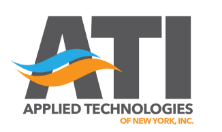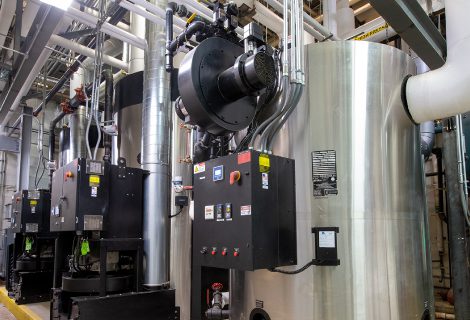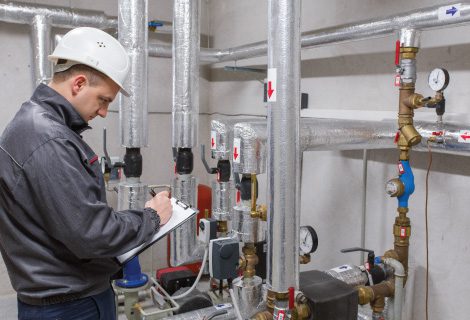Heating the Future: Innovations in Process Manufacturing Energy Efficiency
Process manufacturing as well as other industries heavily rely on several different types of heating systems that are used for an array of purposes. Although each type of heating system has slightly different principles and components, they all work to transfer heat energy through one of the following fundamental methods of heat transfer:
- Conduction
- Convection
- Radiation
Continue reading to learn more about the three different methods of heat transfer and the different types of heating systems.
Different Methods of Heat Transfer
As we previously mentioned, there are three types of heat transfer: conduction, convection, and radiation.
Heat Transfer Through Conduction
Thermal conduction explains the transfer of heat energy across a solid object. Conduction is whenever the energy source is applied directly to the solid object.
Heat Transfer Through Convection
Convection is a heat transfer method where thermal energy is conducted through a medium or fluid (often water), which can create a forced convection current or free flowing convection current:
Forced flow convection involves the medium being circulated by a pump or fan.
Free flowing convection systems are dependent solely on the density gradients or temperature changes.
Heat Transfer Through Radiation
As the indirect method of heat transfer, radiation explains whenever heat energy is transferred by electromagnetic waves. Because the waves have negligible mass, the actual transfer of heat doesn’t require physical contact between substances. With radiant heat transfer, the waves pass through the empty space until they actually contact a physical substance.
Combustion Types of Heating Systems
Combustion types of heating systems or fuel based heaters involve the creation of heat through the burning of gases, liquids, or solids. Once the heat is generated, it can be transferred to the material directly or indirectly. Some of the most common substances used as fuel include:
- Coal
- Oil
- Wood Chips (biogas)
- Natural gas
- Ethanol
- Charcoal
- Cellulose (biogas)
The combustion process is significantly enhanced by adding air or oxygen to the material, which is either indirectly or directly heated.
- In the indirect method, the material is kept separate from the combustion gases in confined vessels.
- In the direct method, the material comes into contact with the combustion gas.
Electric Process Types of Heating Systems
With electrical process heaters, an electromagnetic field or an electric current is used to heat a material through either direct or indirect heating. Through direct electric heating, an electrical current is transmitted through the object — exciting the electrons inside of the object. In contrast, indirect electric heating involves the energy being conducted onto a separate heat element and then into the material.
Boiler & Steam Generator Types of Heating Systems
The majority of the energy utilized throughout process manufacturing facilities is created through the use of industrial boilers. Although every boiler’s design can be different, the equipment will essentially include two different parts a furnace where the combustion happens and heat is generated as well as a vessel where water is turned into steam by heat piped from the furnace.
Most boilers will usually have pressure gauges and may use oil, propane, natural gas, and/or electricity to operate. The heat created from the boiler via steam or hot water can be used to heat homes and generate steam for a wide range of applications and processes. Your application needs and requirements will typically determine the type of boiler or steam generator you need, such as:
- Steam boilers
- Hot water boilers
- Natural gas boilers
- Oil boilers
- Condensing boilers
- Electric boilers
Infrared Radiant Types or Heating Systems
Radiant heating is completely different from other types of heating systems in that it’s engineered for comfort heating through the transfer of heat. The primary function of radiant heaters is to emit heat to warm open spaces.
The benefits of radiant heating make it the perfect application for high ventilation, high ceiling spaces, or infiltration areas, such as comfort and spot heating for outdoor activities. The most common applications for infrared radiant types of heating systems include:
- Warehouses
- Aircraft hangars
- Sports arenas
- Animal pens
- Loading docks
- Golf driving ranges
- Car washes
- Auto body shops
- Factories
- Outdoor restaurants
- Patios
- Pipe fabrication shops
Combined Heat & Power Types of Heating Systems
Also known as cogeneration systems, combined heat and power (CHP) systems generate electricity as well as useful heat energy in an integrated, single system. With CHP systems, the heat that is typically lost in conventional power generation is recaptured as useful energy.
This recapturing of heat energy negates the losses that would be incurred from the individual generation of power and heat. Although conventional methods of producing usable power and heat individually has a normal combined efficiency of approximately 45%, CHP system can perform at levels as high as 80% efficiency.
Contact ATI of New York for the Right Type of Heating System
Unless you’re an engineer or have experience choosing from the different types of heating systems, this process can be daunting and confusing. However, you’re not alone. The professionals at ATI of New York offer decades of experience helping business owners and facility managers choose the best type of heating system for their facility’s heating and process needs.
Contact ATI of New York today to learn more about the different types of heating systems.










